
Contents


Free From Human Intrusion
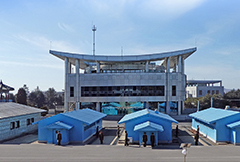

Dreaming of Delightful Zone

Take You to the DMZ

Seeing With the Mind, Talking Through the Lens

the Design of Handheld Fans


Shared Together for Double the Happiness


Founded in the Spirit of Candlelight

Jeju Island, Korea
We Really Want to be a Family of Jeju Island
Matthew Collison relocated from the U.K. with his wife and their three children to beautiful Jeju Island. Here he writes of his experiences of life on the tourist island.
Written & Photographed by Matthew Collison, Freelance writer
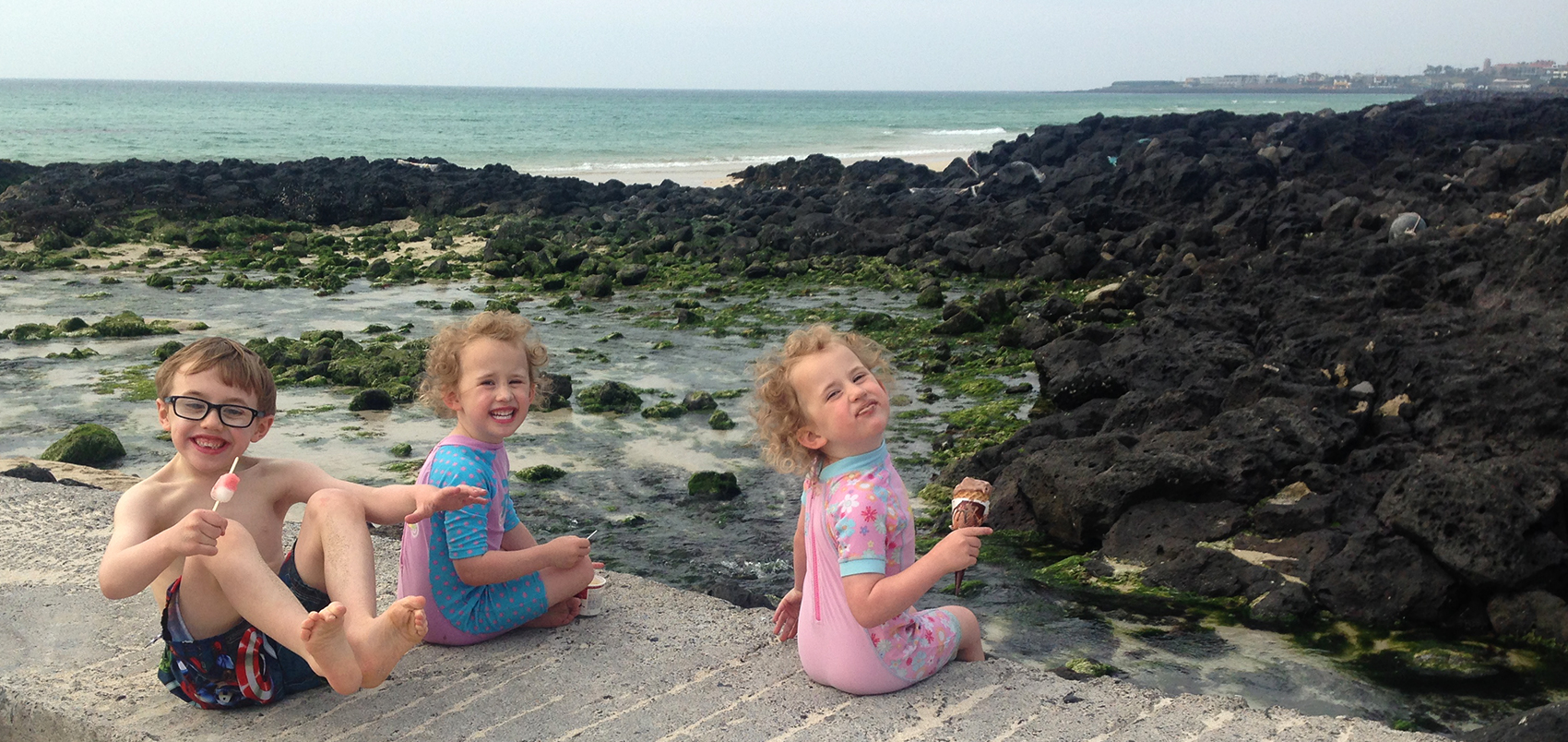
The Big Move From the U.K. to Jeju
The Big Move From the U.K. to Jeju. It was August 2015 when we waved goodbye to our families to begin our new life on Jeju Island. It didn’t take long to realize this would be a great life-changing opportunity. For me, it was a chance to live in a country I had for so long wanted to experience.
Since a young age I have held an interest in Korea and Northeast Asia more broadly. I think it was the Seoul Olympics of 1988 when I first learned about this country. What would it be like to live there, I wondered. A place so far away and different from the life I had come to know in the U.K. I had heard of the country from people who had visited, read of its heritage and traditions in books and newspapers. It was the fortitude of its people who have worked so hard for their country to develop at an astonishing pace that fascinated me. I was interested in Seoul, in particular, where ancient traditions co-exist with the white light of new technology. However, while I pictured Korea in my mind, I never thought I could go there.
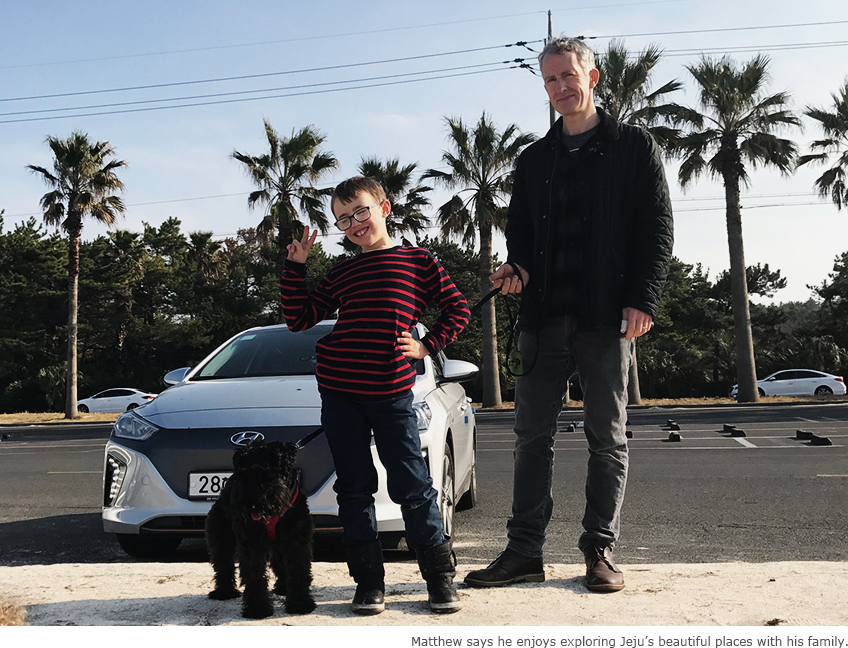
One day the opportunity presented itself. Not as a young graduate, fresh from university, but as an older man, married with a career and three young children. My wife had been offered work at a school on Jeju Island and I was at a stage in my career where I could work either at home or remotely. Our children were in their early years of schooling and at this age we knew it wouldn’t be too disruptive for them to relocate. Moreover, we felt the chance for them to experience a Northeast Asian country and perhaps learn its language at a young age could benefit their personal development. I admit, I knew nothing of Jeju Island, which my cell phone informed me lay some 100 km off the southern coast of the Korean Peninsula, about as far removed from Seoul as one could be in Korea. Little did I know that the mysterious land mass on my phone’s screen would later reveal itself as an island of great beauty, a place of peace and tranquillity, aware of its past and keen to celebrate its heritage and traditions.

Most Westerners who come to Korea to work do so to teach the English language, and this was true for my wife and me. She had secured a new job as an art teacher and I had the chance to continue writing freelance, as well as to do some part time language teaching. Meanwhile, our children commenced their education at an international school where there was a mix of Korean and Western children. Happily, the children have adapted very well, making many Korean friends and even taking their first steps in learning the language. At playtime, one of my son’s favourite games has been ttakji, a game played with folded paper tiles like jacks where the opponent tries to flip your paper tile to win.
Striking a Balance Between
Tradition and Regional Flavors
The Chuseok Mid-Autumn Harvest Festival, one of the two biggest holidays in the country, sees most families return from the big city to their rural hometowns. However, for non-Koreans living in the country, it can be a great time to experience Korean heritage and traditions, particularly its delicious cuisine. Among the most well-known dishes is songpyeon, small half-moon shaped rice cakes eaten during the Chuseok period. These delicious treats have been mostly given to us by local Korean friends, but we have also tried our hand at making our own at workshops run by a local farm.
Jeju Island’s most famous food is perhaps the delicious oranges that grow abundantly across the island, thanks to its warmer climate. In fact, the citrus fruit, which is harvested year-round on Jeju Island, has many different varieties, from the sweetest, but pricey, hallabongs to the smaller noji tangerines. Before coming here, I never realised that oranges exist in so many varieties and tastes. Last autumn, my family and I harvested our own oranges at a neighbouring farm. It was a fun experience and a great opportunity to meet some of the friendly local farmers.
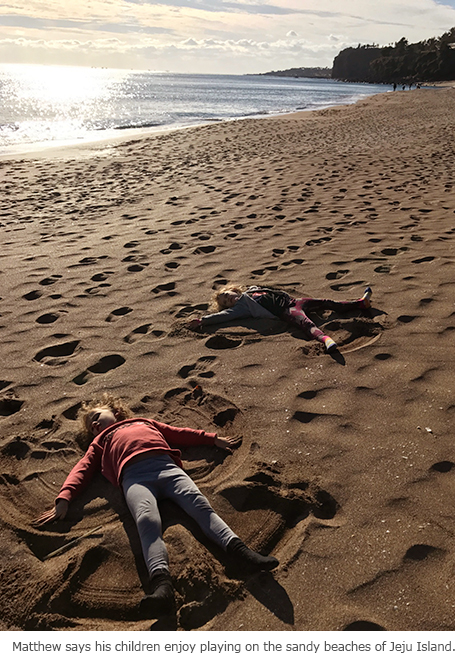

With the sea close by, there’s always plenty of fresh fish and seafood available. It’s baked or grilled, with delicious seasonings, and is available at the many local restaurants or can be bought fresh from a market and cooked yourself.
However, it’s the heuk dwaeji “black pork” that’s the best-loved food in my family. Before coming to Korea, I had read and seen the famous styles of Korean fried and barbecued meat on TV and in magazines, so I was keen to experience it first-hand in Korea, particularly the famed Jeju variety. In fact, it was one of the first meals we had at a restaurant upon arriving in this country and the meal has remained a favourite family treat ever since.
Leading a Fulfilling Life on a
Beautiful Island
Jeju Island is most famous for Hallasan Mountain, South Korea’s highest mountain, and the 1,950 m dormant volcano dominates the skyline from most parts of the island. Being a keen hiker, I was eager to reach the summit when I arrived on Jeju, and have since scaled the peak twice. It’s not a particularly difficult climb, but it’s definitely a rewarding one. Between September and November in the woodlands of the national park at the mountain’s foot, you can walk seemingly for kilometers amid beautiful tinted autumn leaves, or catch the rare sight of a roe deer. At the summit lies the Baengnokdam Crater, the core of Jeju Island, where magnificent views of much of the island’s unique topography can be seen.
Jeju Island’s curved and undulating scenery is due to the hundreds of oreums, or volcanic cones, that are dotted across the landscape. Among the most visited of these is Saebyeol, the site of an annual fire festival. The three-day traditional fair of folk games and activities culminates in the entire hillside being set ablaze. It’s a spectacular event and one rooted firmly in Jeju’s agricultural past.
We’ve discovered countless walking routes leading to unspoilt and lesser trodden parts of the island. From deserted Imperial Japanese airbases to the hidden depths of Jeju’s rocky woodlands, there are plenty of surprises to be had. However, it’s the island’s beautiful coastline that we have most enjoyed as a family. The white sand beaches and the shallow, aqua-colored water of Hyeopjae, or the cliff-lined Jungmun Saekdal, a popular filming location for soap operas, have become some of our favourite places to unwind.
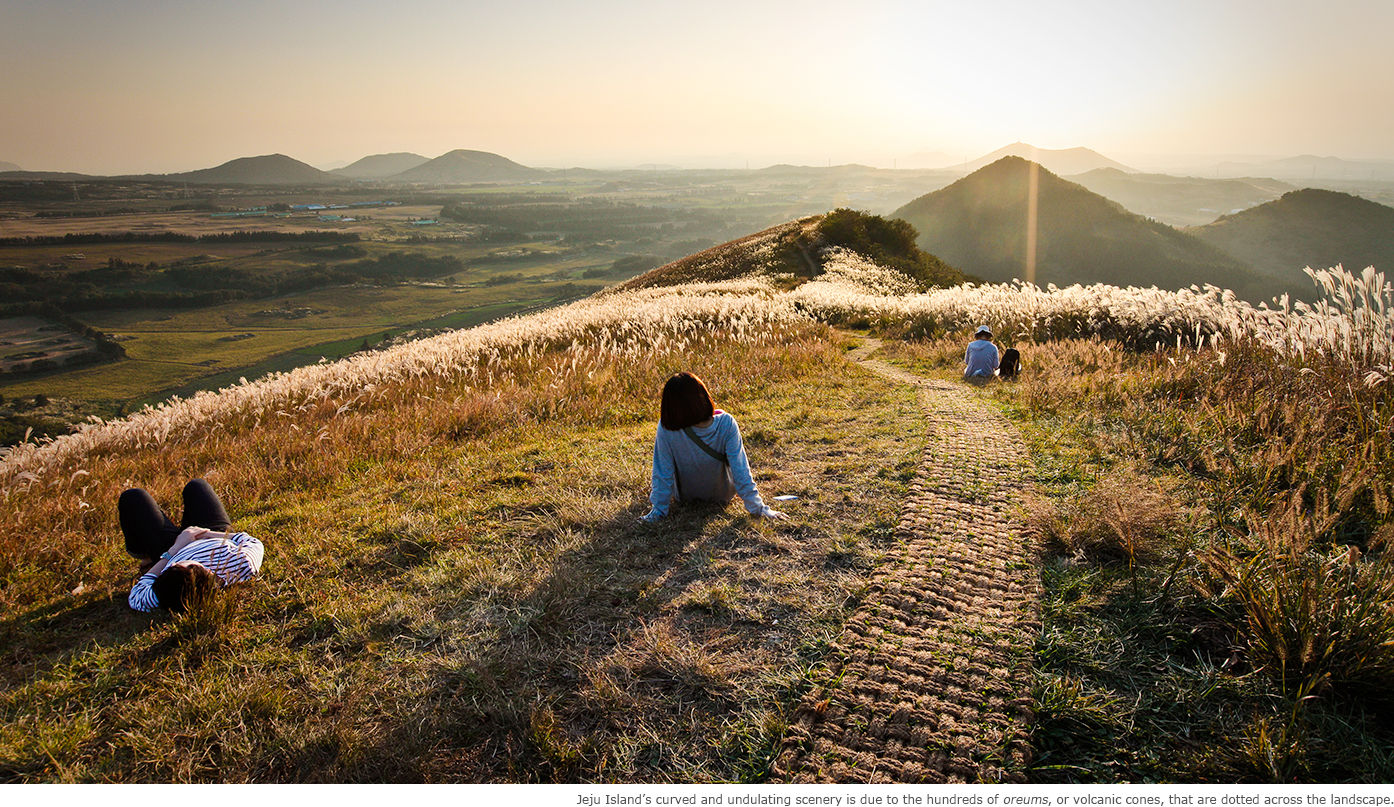
Preserving the Spirit of
Seolmundae Halmang
It has been heart-warming to experience how the people of Jeju have been, not just tolerant and accepting of us as a non-Korean family, but have actively invited us to embrace their community and unique collection of heritage and traditions. I’ve noticed this mostly in the way people interact with our children. Wherever we go, people are often keen to show them kindness and make them smile.
As I’ve progressed with learning the Korean language, I find myself keen to meet more residents of Jeju’s towns and villages. Among the best places to meet the island folk and practice my Korean is at the five-day markets where great-tasting fresh local food can be bought often at bargain prices. It’s mostly women who work the stalls, which is appropriate for an island where females traditionally play the role as provider of the household. Symbolic of this matriarchal role are the famous haenyeo female free-divers who often brave harsh sea conditions to catch delicious abalone and other nutritious seafood delicacies.
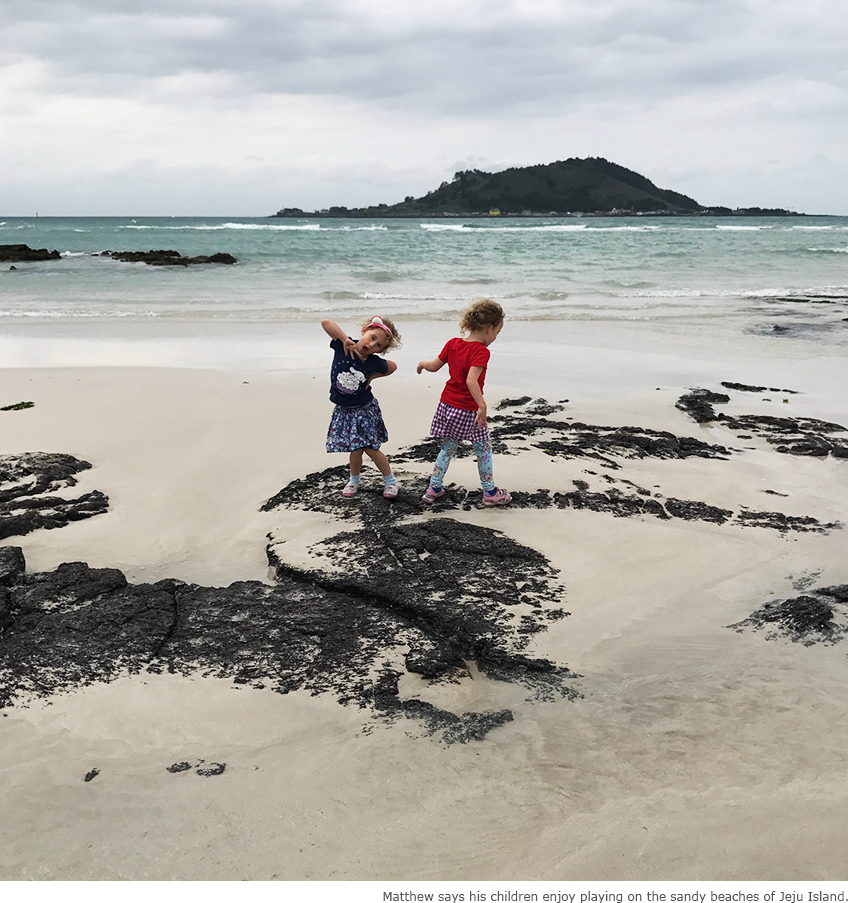
Jeju Island is said to be the mythical island of 18,000 gods at the center of which is Seolmundae, the grandmother goddess who takes the form of Hallasan Mountain. Given the island’s natural beauty, it’s little wonder so many deities would want to be here. It’s in appeasement to these mythic gods that the Tamnaguk Ipchun Gut takes place. Held each year at the Joseon-era Mokgwana area, this shamanistic rite marks the coming of spring and consists of prayers in the hope of a bumper crop in the year ahead. It’s a heady mix of percussion, a blaze of colour and trance-inducing chanting. To me it has come to symbolize both the mystery and wonder of Jeju Island, a place quite unlike any I’ve experienced.
Korea & I features contributions from non-Korean, reflecting the opinions of the writers as faithfully as possible. Thus the opinions expressed therein may differ from the opinions of the editors of <KOREA> magazine.
Other Articles



Dreaming of Delightful Zone


Take You to the DMZ

Seeing With the Mind, Talking Through the Lens




Application of subscription
Sign upReaders’ Comments
GoThe event winners
Go


 June 2018
June 2018


